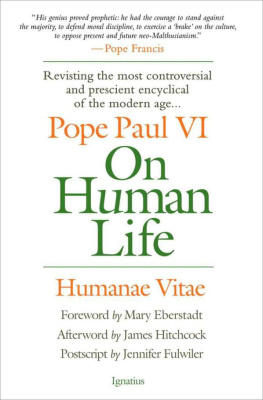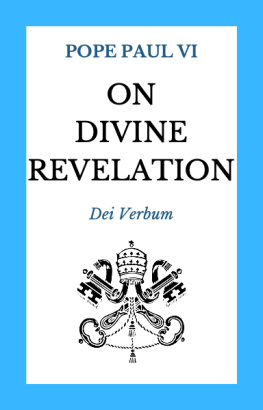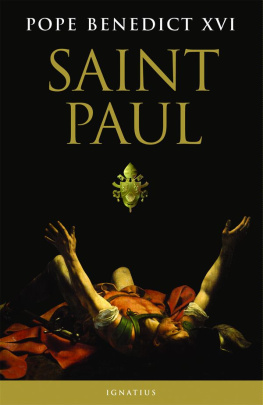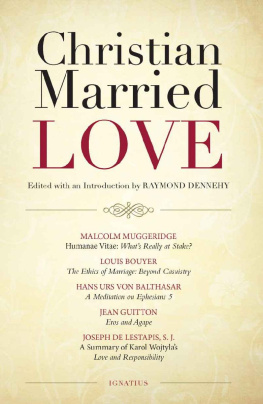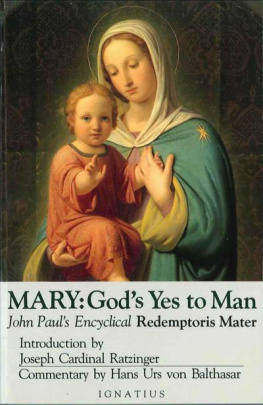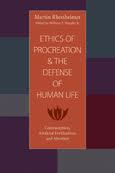ON HUMAN LIFE
HUMANAE VITAE
ON HUMAN LIFE
HUMANAE VITAE
Pope Paul VI
Foreword by Mary Eberstadt
Afterword by James Hitchcock
Postscript by Jennifer Fulwiler
IGNATIUS PRESS SAN FRANCISCO
Humanae Vitae: Encyclical Letter of His Holiness Pope Paul VI on the Regulation of Births , translated by Marc A. Calegari, S.J., 1978, 1998 by Ignatius Press, San Francisco. All rights reserved.
The Vindication of Humanae Vitae is adapted from chapter 8 of Adam and Eve after the Pill: Paradoxes of the Sexual Revolution , by Mary Eberstadt, 2012 by Ignatius Press, San Francisco. All rights reserved.
Cover design by Roxanne Mei Lum
2014 by Ignatius Press, San FranciscoAll rights reserved
ISBN 978-1-62164-001-1
Library of Congress Control Number 2014949935
Printed in the United States of America
CONTENTS
FOREWORD
The Vindication of Humanae Vitae
by Mary Eberstadt
Of all the paradoxical fallout from the Pill, perhaps the least understood today is this: the most unfashionable, unwanted, and ubiquitously deplored moral teaching on earth is also the most thoroughly vindicated by the accumulation of secular, empirical, post-revolutionary fact.
The document in question is of course Humanae Vitae , the encyclical letter of Pope Paul VI on the subject of the regulation of birth, published on July 25, 1968. Now, that Humanae Vitae and related Catholic teachings about sexual morality are laughingstocks in all the best places is not exactly news. Even among believers, everybody grasps that this is one doctrine the world loves to hate. Routine secular reporting on the Church rarely fails to mention the teachings of Humanae Vitae , usually alongside adjectives like divisive and controversial and outdated. In fact, if theres anything on earth that unites the Churchs adversaries, the teaching against contraception is probably it.
Hasnt everyone heard Monty Pythons send-up song Every Sperm Is Sacred? Or heard the jokes? You no play-a the game, you no make-a the rules. And What do you call the rhythm method? Vatican roulette . And What do you call a woman who uses the rhythm method? Mommy .
As everyone also knows, its not only the Churchs self-declared adversaries who go in for this sort of sportso, too, do many American and European Catholics. I may be Catholic, but Im not a maniac about it , runs their unofficial subtextmeaning, Im happy to take credit for enlightened Catholic positions on the death penalty, social justice, and civil rights, but, of course, I dont believe in those archaic teachings about divorce, sexuality, and, above all, birth control.
Such is the current fate of Humanae Vitae and all it represents in the Church in Americaand, for that matter, in what is left of the advanced Western one, too. With each passing year, it seems safe to assume, fewer priests can be found to explain the teaching, fewer parishioners to obey it, and fewer educated people to avoid rolling their eyes at the idea that anyone by now could possibly be so antiquarian or purposefully perverse as to hold any opinion about contraceptive sexany, that is, other than its full-throttle celebration as the chief liberation of our time.
And in just that apparent consensus about the ridiculousness of it all, amid all those ashes scattered over a Christian teaching stretching back two millennia, arises a fascinating and in fact exceedingly amusing modern morality taleamusing, at least, to those who take their humor dark.
He who sits in the heavens laughs (Ps 2:4), the Psalmist promises, specifically in a passage about enjoying vindication over ones adversaries. If that is so, then the racket by now must be prodigious. Not only have the documents signature predictions been ratified in empirical force, but they have been ratified as few predictions ever are: in ways its authors could not possibly have foreseen, including by information that did not exist when the document was written, by scholars and others with no interest whatever in its teaching, and indeed even inadvertently, and in more ways than one, by many proud public adversaries of the Church.
Forty-plus years after Humanae Vitae , fifty-plus after the approval of the Pill, there are more than enough ironies, both secular and religious, to make one swear theres a humorist in heaven.
Begin by meditating upon what might be called the first of the secular ironies now evident: Humanae Vitae s specific predictions about what the world would look like if artificial contraception became widespread. The encyclical warned of four resulting trends: a general lowering of moral standards throughout society; a rise in infidelity; a lessening of respect for women by men; and the coercive use of reproductive technologies by governments.
All this is to say that, beginning just before the appearance of Humanae Vitae , an academic and intellectual rethinking began that can no longer be ignoredone whose accumulation of empirical evidence points to the deleterious effects of the sexual revolution on many adults and children.
Who could deny that the predictions of Humanae Vitae and, by extension, of Catholic moral theology have been ratified with data and arguments that did not even exist in 1968? But now comes the question that just keeps on giving. Has this dramatic reappraisal of the empirically known universe led to any wider secular reappraisals, however grudging, that the Catholic Church may have gotten something right after all? The answer is manifestly that it has not. And this is only the beginning of the dissonance that surrounds us.
The years since the Pills approval have similarly destroyed the mantle called science that Humanae Vitae s detractors once wrapped around themselves. In particular, the doomsday population science so popular and influential during the era in which Humanae Vitae appeared has been repeatedly demolished.
An entomologist who specialized in butterflies, Ehrlich found an American public, including a generation of Catholics, extraordinarily receptive to his direst thoughts about humanity.
This was the wave that The Population Bomb caught on its way to becoming one of the bestsellers of its time. Of course, many people with no metaphysics whatsoever were drawn to Ehrlichs doom-mongering. But for restless Catholics, in particular, the overpopulation scare was attractivefor if overpopulation could be posited as the problem, the putative solution was obvious: Make the Church lift the ban on birth control.
It is less than coincidental that the high-mindedness of saving the planet dovetailed perfectly with a more self-interested outcome: the freer pursuit of sexuality via the Pill. Dissenting Catholics had special reasons to stress the science of overpopulation, and so they did. In the name of a higher morality, their argument went, birth control could be defended as the lesser of two evils (a position argued by the dissenter Charles Curran, among others).
This is all the more satisfying a ratification because Connelly is so conscientious in establishing his own personal antagonism toward the Catholic Church (at one point asserting without even a footnote that natural family planning still fails most couples who try it).
Population science was not only failing to help people, Connelly argues, but also actively harming some of themand in a way that summoned some of the baser episodes of recent historical memory:
As a related matter, the years since Humanae Vitae appeared have also vindicated the encyclicals fear that governments would use the new contraceptive technology coercively. The outstanding example, of course, is the Chinese governments long-running one-child policy, replete with forced abortions, public tracking of menstrual cycles, family flight, increased female infanticide, sterilization, and other assaults too numerous even to begin cataloguing here. Lesser-known examples include the Indian governments foray into coercive use of contraception in the emergency of 1976 and 1977, and the Indonesian governments practice in the 1970s and 1980s of the bullying implantation of IUDs and Norplant.
Next page
